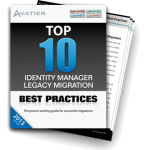If you’re in charge of information security risk management for your organization, you know that the process is a study in trade-offs. You have to deal with acute, urgent problems — happenstances that are disrupting workflow in the here-and-now. But then there are those chronic drags — costly inefficiencies, latent security vulnerabilities and inadequate training protocols. Balanced scorecard software is about top-down organizational alignment with strategic goals — it keeps you on track to successfully execute your objectives and capture the metrics important to measuring and aligning your IT operations to your company goals.
How does balanced scorecard software work? It helps you manage and prioritize key areas of concern and opportunity impacting operations. This puts you in a position to align your IT organization to the business. When used to its maximum advantage, this insight creates better customer experiences, operational efficiencies, and ultimately shareholder value.
There are four key benefits to balanced scorecard software:
Risk Trending Security Metrics
The ability to quickly monitor and pinpoint potential risks and vulnerabilities associated with IT safeguards, hardware problems, software issues, outages and information security risks. A mere snapshot is not enough — the ability to track risk factors over time highlights problems so they don’t negatively impact your balanced scorecard goal.
Balanced scorecard software visually represents IT security metric information so that it’s easily digested and understood by executives and business management. You and your team can study risk trends along with objective analytics to sustain risk management compliance over time — and, you can establish a variety of audit controls to better capture performance and prioritize accordingly.
Customizable Risk Categories
Customizable categories let you focus on overlapping measurements for a holistic risk assessment. Every organization is different, so this capability ensures that you’re measuring and reporting on factors associated to your unique balance scorecard goals, organizational objectives, measurements and success criteria.
No matter what’s keeping you up at night — lowering operational costs, making IT transparent to business processes, or preventing security breaches and loss of intellectual property — you can set up your balanced scorecard software to track it for you. Simple, clean dashboards with display bubble scoring and color coding combined with visual representation of degree of risk simplifies data analysis and communication. You don’t have to sift through and decipher the data — it’s all there for quick, clear and timely reference.
Compliance Tracking and Reporting
With the compliance regulations around enterprise risk management, it’s critical to build in balanced scorecard categories that monitor and track critical requirements. Balanced scorecard software tracks and measures compliance factors including organizational protocols and procedures, disclosure requirements, legal and regulatory exposure along with your performance against a goal.
Compliance tracking not only reduces potential threats but also significantly improves operational efficiency. You specify your controls and the software monitors your compliance and tracks adherence to protocols while simultaneously exposing areas of concern and vulnerability. Results are tracked in a secure environment for balanced scorecard reporting, and you’re able to pinpoint problems so you can take action based on real-time intelligence.
One Page One Click Risk Management
The beauty of balanced scorecard software is that its highly configurable and sophisticated on the back end with an intuitively logical interface. This allows teams and stakeholders to readily monitor trends and honing in on key areas of concern.
Successfully navigating enterprise risk management is predicated on the ability to sift through the complex relationships between interrelated factors and coming away with understandable, actionable reports that facilitate the decision making process.
Balanced scorecard software provides an innovative and logical approach to aligning strategic goals to performance measures so you can immediately address issues impacting your business and rewards.
Watch the Enterprise Risk Management Video
Ryan Ward, Chief Innovation Officer at Avatier, describes how to return identity and access management to the business user with Avatier’s Identity Access Management software. With Avatier access certification, user provisioning, active directory group management, and self-service password reset are done through self-service and automation. Avatier’s identity management software capabilities can be delivered faster than our competitors, because our unique configuration approach eliminates the custom development required by other vendors. Ultimately, Avatier’s solutions put accountability in the hands of business users rather than IT. As Avatier pushes the boundaries of innovation with exciting new built-in audit controls and self-service ITIL service catalog capabilities, we continue to simplify and redefine the IT service catalog, access governance, enterprise risk management, and enterprise password management.
Get the Top 10 Identity Manager Migration Best Practices Workbook
 Start your migration from legacy software with the Top 10 Identity Manager Migration Best Practices Workbook. Use this workbook to think through your information security risk before you transition to next generation identity manager software.
Start your migration from legacy software with the Top 10 Identity Manager Migration Best Practices Workbook. Use this workbook to think through your information security risk before you transition to next generation identity manager software.




